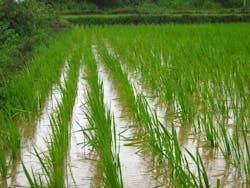Flooding on the Farm
The Midwest floods this spring and summer damaged crops, reducing farmer returns with record-high input costs and substantially higher crop prices. This brief agricultural flood damage overview, exploring the effects of flooding and flooded farms, focuses first on immediate factors, then on longer-term factors occurring within the season and in subsequent years.
Flooding & Oxygen Depletion
From a plant perspective, the immediate cause of damage and death is oxygen depletion, as water contains less oxygen than air. Four factors increase oxygen depletion in flooded crops and hence imply more crop damage. First, temperature determines plant respiration rates (oxygen consumption), so warmer floodwaters imply faster depletion of dissolved oxygen and more crop damage. Spring flooding, therefore, can be less damaging to crops than summer flooding because the water is cooler. Second, the duration of crop submersion is an important factor—the longer a crop is underwater, the longer it goes with low oxygen, and so more damage occurs.
Third, water movement is key because moving water typically has more dissolved oxygen than still or sluggish water. Of course, rapidly moving water can push plants over (“lodging”) or wash them away, causing obvious crop damage. However, from an oxygen-depletion perspective, moving water implies less flood damage to crops than stagnant water. Finally, crop development is important. For example, young corn and soybean plants are more sensitive to flooding than older plants, but flooding of more mature crops during other critical phases (e.g., flowering) can also be damaging. Development determines crop height relative to floodwater depth; even a small amount of a plant sticking out of the water gives some oxygen so that the plant can better survive. Ultimately, the worst-case scenario for crop damage from flooded farms is several days of complete submersion in warm, stagnant water during a critical crop phase.
How Flooding Impacts Disease & Nitrogen Loss
Even after floodwaters recede, crops can continue to suffer damage and yield resulting losses. Flooding not only weakens plant defenses, but the soil and water conditions prevalent during flooding favor the development of many plant pathogens, so crops suffer increased disease problems after floods. Among these diseases are root rots and stalk rots, which are caused by several different microorganisms, “crazy top” and various foliar diseases. Some of these diseases can be controlled by application of fungicides, but this increases production costs.
Flooding also cause loss of soil nitrogen because of enhanced denitrification during anaerobic soil conditions which persist during flooding. Nitrogen is important for crop growth, and most farmers apply some additional nitrogen to their crops, especially corn. Because denitrification is an anaerobic microbial process, the same flood factors that determine oxygen depletion for crops—temperature, duration and water movement—also determine the soil oxygen level; the less soil oxygen, the more soil nitrogen lost via denitrification. Methods exist to estimate nitrogen losses, and if the soil is not too wet for machinery, nitrogen can be reapplied, though this increases costs and nitrogen prices have been rising rapidly.
The Effects of Flooding on Competition & Erosion
Flooded crops can be developmentally delayed and unable to achieve canopy closure, critical for crops to out-compete weeds and achieve high yields. Farmers may need to use additional weed control (chemical or mechanical), which increases costs, and late-spring control is often less effective or causes greater crop damage. Also, flooded farms can bring in new weed seeds that increase control costs and reduce yields in future years.
Finally, flooding moves soil that can further damage crops. Erosion washes the fertile top soil away, increasing input costs and reducing yields in future years. Soil deposition is another significant problem. More than a few inches of deposition, even of fertile silt, can smother an existing crop. Sand and gravel can also be deposited on cropland by floodwaters, necessitating the removal or spreading out and mixing in of these deposits, which likely are not as fertile as the existing soil and thus imply higher input costs and lower yields in future years.
Resources
For more information, contact local county extension agents in affected areas or extension state specialists in departments of agronomy, crop science or related disciplines at the appropriate land-grant university.


